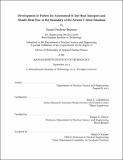| dc.contributor.advisor | Brian L. LaBombard. | en_US |
| dc.contributor.author | Brunner, Daniel Frederic | en_US |
| dc.contributor.other | Massachusetts Institute of Technology. Department of Nuclear Science and Engineering. | en_US |
| dc.date.accessioned | 2014-05-07T14:47:24Z | |
| dc.date.available | 2014-05-07T14:47:24Z | |
| dc.date.copyright | 2013 | en_US |
| dc.date.issued | 2013 | en_US |
| dc.identifier.uri | http://hdl.handle.net/1721.1/86420 | |
| dc.description | Thesis: Ph. D., Massachusetts Institute of Technology, Department of Nuclear Science and Engineering, 2013. | en_US |
| dc.description | This electronic version was submitted by the student author. The certified thesis is available in the Institute Archives and Special Collections. | en_US |
| dc.description | Cataloged from student-submitted PDF version of thesis. Pages [228-229] blank. | en_US |
| dc.description | Includes bibliographical references. | en_US |
| dc.description.abstract | Progress towards a viable fusion reactor will require comprehensive understanding of boundary plasma physics. Knowledge in this area has been growing, yet there are critical gaps. Measurements of the sheath heat flux transmission coefficient-a fundamental physical quantity whose theoretical value is ~ 7-have varied from 2 to 20. Values below 5 are physically impossible and have challenged the understanding of this very basic theory. In addition, measurements of ion temperature are sparse and ion energy transport is poorly understood. To this end a set of new diagnostics, including a surface thermocouple, ion sensitive probe, and retarding field analyzer, have been developed that can tolerate the extreme heat fluxes in the Alcator C-Mod boundary plasma. These probes are used to asses issues of heat flux and ion energy transport. Systematic studies with these new tools reveal the following: A comparison of surface thermocouples and Langmuir probes confirms standard sheath heat flux theory in a tokamak for the first time. The measurement of unphysically low sheath heat flux transmission coefficients and an anomalous increase in measured divertor pressure by Langmuir probes, which is also unphysical, are found the be linked. Plasma-neutral simulations indicate that these artifacts are due to the Langmuir probe bias modifying the local plasma. Important space charge limits to measurements with ion sensitive probes are found experimentally and explored in depth with a 1D kinetic simulation. These results clarify the plasma conditions under which an ion sensitive probe may be used to measure ion temperature and/or plasma potential. The retarding field analyzer is demonstrated to be a viable ion temperature diagnostic up to the last closed flux surface in C-Mod. A ₁D fluid simulations is built to interpret edge ion heat transport. At high collisionality-where the fluid approximations are valid: the simulation reproduces the measured edge ion-to-electron temperature ratio (~ 2). However, at low collisionality-where fluid approximation is not valid-the simulation is not able to reproduce the experimental temperature ratio (~ 4). The addition of kinetic heat flux limiters can bring the simulated ratio into agreement with measurements. The value of heat flux limiter is found to be consistent with that expected from kinetic theory. | en_US |
| dc.description.statementofresponsibility | by Daniel Frederic Brunner. | en_US |
| dc.format.extent | 227, 2 unnumbered pages | en_US |
| dc.language.iso | eng | en_US |
| dc.publisher | Massachusetts Institute of Technology | en_US |
| dc.rights | M.I.T. theses are protected by copyright. They may be viewed from this source for any purpose, but reproduction or distribution in any format is prohibited without written permission. See provided URL for inquiries about permission. | en_US |
| dc.rights.uri | http://dspace.mit.edu/handle/1721.1/7582 | en_US |
| dc.subject | Nuclear Science and Engineering. | en_US |
| dc.title | Development of probes for assessment of ion heat transport and sheath heat flux in the boundary of the Alcator C-Mod Tokamak | en_US |
| dc.type | Thesis | en_US |
| dc.description.degree | Ph. D. | en_US |
| dc.contributor.department | Massachusetts Institute of Technology. Department of Nuclear Science and Engineering | |
| dc.identifier.oclc | 878530775 | en_US |
